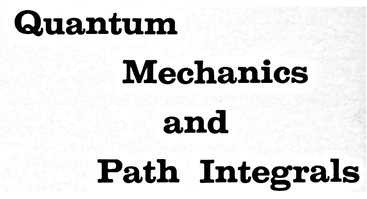
\(\)
Problem 9-10
In order to study the electromagnetic energy correction \(\delta E\), we shall consider the simplest case: that in which the matter system has only one moving charge (e.g., a hydrogen atom with an infinitely heavy nucleus or a free electron in empty space) whose coordinates we shall call \(\def\mb#1{\mathbf{#1}}\mb{R}\). Thus \(\mb{j}_{\mb{k}}=e\dot{\mb{R}}\,e^{-i\mb{k}\cdot\mb{R}}\). We have here a case where \(\mb{j}_{\mb{k}}\) contains \(\dot{\mb{R}}\), and in considering second-order terms we must take appropriate care, as discussed in Sec. 7-3. There is an additional term to \(\delta E\) from the squared velocity term \(\dot{\mb{R}}^{2}\). Expressing \(\dot{\mb{R}}\) in terms of the momentum operator \(\mb{p}\), as in Sec. 7-5, we obtain
\def\pdiff#1{\frac{\partial}{\partial #1}}
\def\reverse#1{\frac{1}{#1}}
\def\Bppdiff#1#2{\frac{\partial^{2} #1}{\partial #2^{2}}}
\def\ppdiff#1#2{\frac{\partial #1}{\partial #2}}
\def\BK#1#2{\langle #1 | #2 \rangle}
\def\BraKet#1#2#3{\langle #1 | #2 | #3 \rangle}
\def\ket#1{| #1 \rangle}
\def\bra#1{\langle #1 |}
\delta E_1 &= \frac{e^{2}}{m^{2}}\sum_{N} \int \frac{d^{3}\mb{k}}{(2\pi)^{3}}\frac{2\pi\hbar}{kc}
\bigg(\big|\big(\mb{p}_1\,e^{-i\mb{k}\cdot\mb{R}}\big)_{NM}\big|^{2}
+\big|\big(\mb{p}_2\,e^{-i\mb{k}\cdot\mb{R}}\big)_{NM}\big|^{2}\bigg)
\frac{1}{E_M-E_N-\hbar kc}\notag\\
&\qquad +\frac{e^{2}}{m}\int \frac{d^{3}\mb{k}}{(2\pi)^{3}}\frac{2\pi\hbar}{kc}
\tag{9-71}
\end{align}
Why do we not need to be careful to write \(\frac{1}{2}\left[\mathbf{p}_1\,e^{-i\mathbf{k}\cdot\mathbf{R}}+e^{-i\mathbf{k}\cdot\mathbf{R}}\,\mathbf{p}_1\right]\) in the matrix elements? [1]( 注意 ) 原書では, 題意の式 (9-71) 中の行列要素が \(\big(\mb{p}_1\,e^{-i\mb{k}\cdot\mb{R}}\big)_{NM}\) などと書かれているが, 解答する過程で これは … Continue reading
( 解答 ) 輻射場中に物質系が存在すると, その系から光子の吸収・放出が生起する.ここでは, 電磁場中に電荷 \(e\) を持って運動する荷電粒子(例えば原子内電子)が一個だけ存在する場合を考える.この系の粒子と輻射場の相互作用ハミルトニアン \(H_I\) は次となる (前述のブログ記事中の式 (1.64) で \(i=1\) とした場合):
H_I =-\frac{e}{2m}\big(\mb{p}\cdot\mb{A}+\mb{A}\cdot\mb{p}\big) + \frac{e^{2}}{2mc^{2}}\mb{A}^{2}
\tag{1}
\end{equation}
しかし「輻射(電磁波)は横波である」から, ここで「横波条件」: \(\nabla\cdot\mb{A}=0\) を想定する(「クーロン・ゲージ」を用いる)ならば, \(\mb{p}\cdot\mb{A}\) は \(\mb{A}\cdot\mb{p}\) に置き換えることが許される [2]運動量 \(\mb{p}\) を量子化して演算子 \(\mb{p}=-i\hbar\nabla\) に置き換えて, \(H_I\) をハミルトニアン演算子 \(\hat{H}_I\) に移行する: \begin{equation} \hat{H}_I = … Continue reading. 従って, 上式は次式のように書くことが出来る:
H_I = -\frac{e}{mc}\mb{A}\cdot\mb{p} + \frac{e^{2}}{2mc^{2}}\mb{A}^{2}
\tag{2}
\end{equation}
この相互作用によって, 粒子は光子を放出・吸収し, その粒子状態は始状態 \(\ket{M}\) から終状態 \(\ket{N}\) へ遷移する.
従って, 例えば「放出過程」を考えるならば, その遷移行列の「行列要素」でゼロでないのは, 式 (2) の \(H_I\) を用いて次となる (やはり前述のブログ記事中の式 (1.65) で \(i=1\) とし偏極が \(r=1\) の場合):
\BraKet{N,n_1(\mb{k})+1}{H_I}{M,n_1(\mb{k})}
&=\bra{N,n_1(\mb{k})+1}\left\{-\frac{e}{mc}\mb{A}\cdot\mb{p}+\frac{e^{2}}{2mc^{2}}\mb{A}^{2}\right\}\ket{M,n_1(\mb{k})}\\
&=\bra{N,n_1(\mb{k})+1}\left(-\frac{e}{mc}\mb{A}^{-}\cdot\mb{p}\right)\ket{M,n_1(\mb{k})}\\
&=-\frac{e}{mc}\bra{N,n_1(\mb{k})+1}\,\big\{\mb{\varepsilon}_1(\mb{k})a^{\dagger}_1(\mb{k})\,e^{-i(\mb{k}\cdot\mb{x}-\omega_{\mb{k}}t)}\big\}\cdot\mb{p}\,\ket{M,n_1(\mb{k})}\\
&=-\frac{e}{mc}\left(\frac{\hbar c^{2}}{2V\omega_{\mb{k}}}\right)^{1/2}\BraKet{n_1(\mb{k})+1}{a^{\dagger}_1(\mb{k})}{n_1(\mb{k})}\,
\bra{N}\left(e^{-i(\mb{k}\cdot\mb{x}-\omega_{\mb{k}}t)}\,\mb{\varepsilon}_1(\mb{k})\cdot\mb{p}\right)\ket{M}\\
&=-\frac{e}{m}\left(\frac{\hbar}{2V\omega_{\mb{k}}}\right)^{1/2}\sqrt{n_1(\mb{k})+1}\,\BraKet{N}{e^{-i\mb{k}\cdot\mb{x}}\,\mb{p}_1}{M}\,e^{i\omega_{\mb{k}}t}
\tag{3}
\end{align}
ただし \(\mb{p}_1=\mb{\varepsilon}_1(\mb{k})\cdot\mb{p}\) とした.すなわち \(\mb{p}_1\) は, 運動量 \(\mb{p}\) の偏極ベクトル \(\mb{\varepsilon}_1(\mb{k})\) 方向の成分である.
次に, この相互作用ハミルトニアン \(H_I\) に 式 (2) でなく, 「ゲージ条件: \(\nabla\cdot\mb{A}=0\) を考慮しない式 (1) をそのまま用いて」みよう.その場合の「遷移行列」は次となる:
&\BraKet{N,n_1(\mb{k})+1}{H_I}{M,n_1(\mb{k})}\\
&\quad=\bra{N,n_1(\mb{k})+1}\left\{-\frac{e}{2mc}\big(\mb{A}\cdot\mb{p}+\mb{p}\cdot\mb{A}\big)
+\frac{e^{2}}{2mc^{2}}\mb{A}^{2}\right\}\ket{M,n_1(\mb{k})}\\
&\quad=\bra{N,n_1(\mb{k})+1}\left\{-\frac{e}{2mc}\big(\mb{A}^{-}\cdot\mb{p}+\mb{p}\cdot\mb{A}^{-}\big)\right\}\ket{M,n_1(\mb{k})}\\
&\quad=-\frac{e}{2mc}\bra{B,n_1(\mb{k})+1}\left\{\big(\mb{\varepsilon}_1(\mb{k})a^{\dagger}_1(\mb{k})\,e^{-i(\mb{k}\cdot\mb{x}-\omega_{\mb{k}}t)}\big)\cdot\mb{p}+\mb{p}\cdot\big(\mb{\varepsilon}_1(\mb{k})a^{\dagger}_1(\mb{k})\,e^{-i(\mb{k}\cdot\mb{x}-\omega_{\mb{k}}t)}\big)\right\}\ket{M,n_1(\mb{k})}\\
&\quad=-\frac{e}{2mc}\left(\frac{\hbar c^{2}}{2V\omega_{\mb{k}}}\right)^{1/2}\BraKet{n_1(\mb{k})+1}{a^{\dagger}_1(\mb{k})}{n_1(\mb{k})}\,\bra{N}\left(e^{-i(\mb{k}\cdot\mb{x}-\omega_{\mb{k}}t)}\,\mb{\varepsilon}_1(\mb{k})\cdot\mb{p}+\mb{p}\cdot\mb{\varepsilon}_1(\mb{k})\,e^{-i(\mb{k}\cdot\mb{x}-\omega_{\mb{k}}t)}\right)\ket{M}\\
&\quad=-\frac{e}{m}\left(\frac{\hbar}{2V\omega_{\mb{k}}}\right)^{1/2}\sqrt{n_1(\mb{k})+1}\,\BraKet{N}{\,\frac{1}{2}\big(e^{-i\mb{k}\cdot\mb{x}}\,\mb{p}_1+\mb{p}_1\,e^{-i\mb{k}\cdot\mb{x}}\big)\,}{M}\,e^{i\omega_{\mb{k}}t}
\tag{4}
\end{align}
この結果は, 式 (3) の行列要素を次のように置き換えたものになっている:
\BraKet{N}{e^{-i\mb{k}\cdot\mb{x}}\,\mb{p}_1}{M}\quad\rightarrow\quad
\BraKet{N}{\,\frac{1}{2}\big(e^{-i\mb{k}\cdot\mb{x}}\,\mb{p}_1+\mb{p}_1\,e^{-i\mb{k}\cdot\mb{x}}\big)\,}{M}
\tag{5}
\end{equation}
従って, 『輻射場は「横波の条件」(transversality condition) すなわち「クーロン・ゲージ」(Coulomb gauge) を満たす必要があることを考慮する」ならば, 行列要素中の演算子に \(e^{-i\mb{k}\cdot\mb{x}}\,\mb{p}_1\) でなく \(\displaystyle{\frac{1}{2}\big(e^{-i\mb{k}\cdot\mb{x}}\,\mb{p}_1+\mb{p}_1\,e^{-i\mb{k}\cdot\mb{x}}\big)}\) を用いる必要はないことが分かった.
References
| ↑1 | ( 注意 ) 原書では, 題意の式 (9-71) 中の行列要素が \(\big(\mb{p}_1\,e^{-i\mb{k}\cdot\mb{R}}\big)_{NM}\) などと書かれているが, 解答する過程で これは \(\big(e^{-i\mb{k}\cdot\mb{R}}\,\mb{p}_1\big)_{NM}\) などと表記した方が良いように思われた. |
|---|---|
| ↑2 | 運動量 \(\mb{p}\) を量子化して演算子 \(\mb{p}=-i\hbar\nabla\) に置き換えて, \(H_I\) をハミルトニアン演算子 \(\hat{H}_I\) に移行する: \begin{equation} \hat{H}_I = -\frac{e}{2m}\big\{(-i\hbar\nabla)\cdot\mb{A}+\mb{A}\cdot(-i\hbar\nabla)\big\} + \frac{e^{2}}{2mc^{2}}\mb{A}^{2} =i\frac{e\hbar}{2m}\big(\nabla\cdot\mb{A} +\mb{A}\cdot\nabla\big) + \frac{e^{2}}{2mc^{2}}\mb{A}^{2} \end{equation} このとき, \(\nabla\cdot\mb{A}(\mb{x})\) はその右側に来る位置 \(\mb{x}\) の波動関数 \(\psi(\mb{x})\) に作用する演算子であることに注意する.すると \(\nabla\) の性質から, \begin{equation} \nabla\cdot\mb{A}(\mb{x})\,\psi(\mb{x}) =\big\{\nabla\cdot\mb{A}(\mb{x})\big\}\psi(\mb{x}) + \mb{A}(\mb{x})\cdot\nabla\psi(\mb{x}) \end{equation} となる.しかし, 横波の条件:\(\nabla\cdot\mb{A}=0\) により, 第1項はゼロとなる.よって, \begin{equation} \nabla\cdot\mb{A}(\mb{x})\,\psi(\mb{x}) =\mb{A}(\mb{x})\cdot\nabla\psi(\mb{x}),\quad\rightarrow\quad -i\hbar\nabla\cdot\mb{A} = \mb{A}\cdot(-i\hbar\nabla),\quad\rightarrow\quad \hat{\mb{p}}\cdot\mb{A}=\mb{A}\cdot\hat{\mb{p}} \end{equation} となり, 結局 \(\hat{\mb{p}}\cdot\mb{A}\) は \(\mb{A}\cdot\hat{\mb{p}}\) で置き換えることが許されることになる. |

